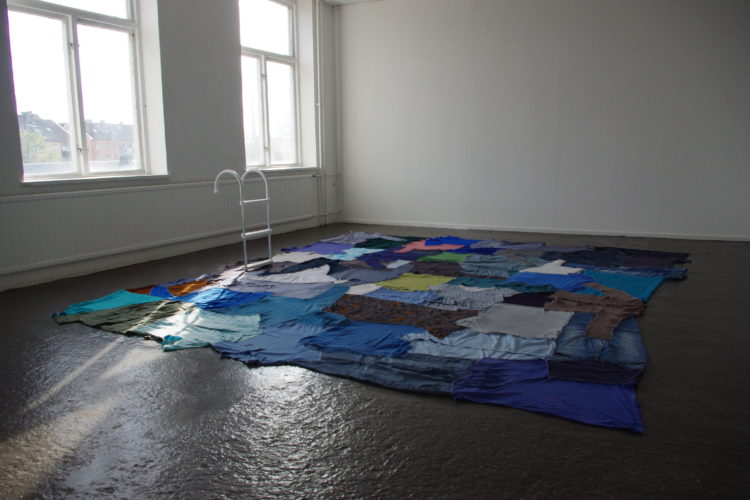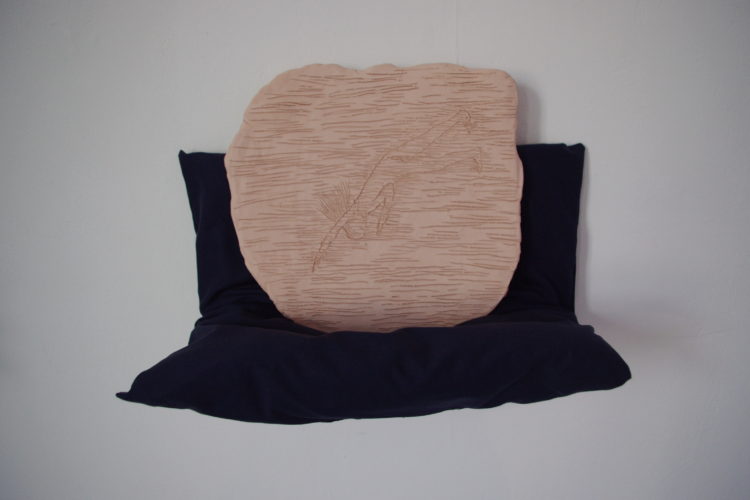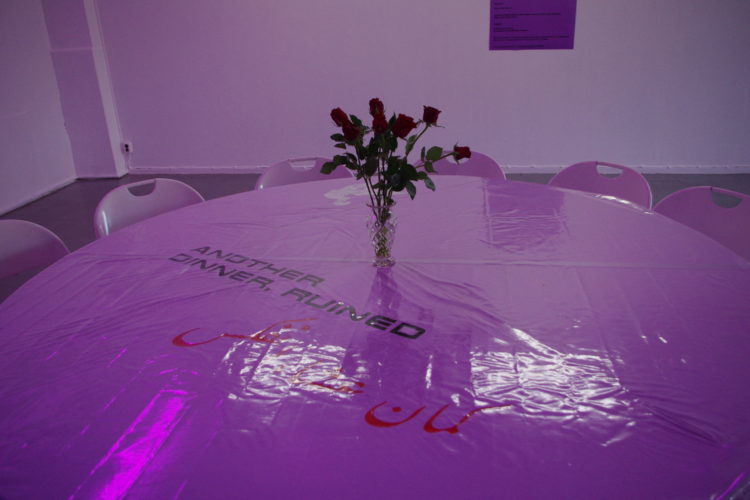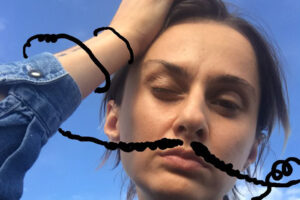December 5, 2019
By Valentina Iancu
What’s Left From My Heart
Poetic titles formulated as political metaphors were always a mark of the curatorial and artistic projects signed by Simona Dumitriu in Romania, and since 2017 at the Skånes konstförening gallery in Malmö. Since last year, her activity has been accompanied by Tawanda Appiah, a curator from Zimbabwe with whom she has continued to create a safer space for intersectional cultural content. With a theoretical framework informed by queer thinking and the contribution of decolonial discourse brought by Tawanda Appiah, the curatorial collaboration between the two is a poetic probing of personal subjectivities.
The exhibition What’s left from my heart: FCNN, Ileana Faur & Raluca Croitoru marking the end of this program, is a sublime contemporary feminist manifesto by the curators, crystallized around personal history, emotional subjectivity and solidarity. Dumitriu and Appiah have transformed the Skånes konstförening gallery space into a contemporary platform that generates and mediates necessary meetings between artists and activists, the exhibition being a tool for connecting and exchanging complementary positions. Within a scene that is struggling to continuously perform its openness to diversity, while having the resources and the institutional infrastructure to do so, it is an urgency for contemporaneity – from my point of view – to address the possibility of a culture formulated at the intersection of the topics that truly define today’s international art scene. The exhibition as a medium is suffocated by the endless history of white masculinity, cisgender, heterosexual domination oriented towards capitalist consumption, thus becoming dthus becoming delegitimized because of art’s ever growing transformation into goods that can be exchanged in the power games of capital. The practice of the two curators transforms the exhibition space into what I felt as a safe space, a context for encounters between people and sensibilities. “Art exhibitions are not prisoners of linear narratives, as is writing. They are not delivered page after page from left to right (or from right to left). Rather, the exhibitions are the contingent of a particular space – where stories can be told, however this does not make them any more concrete – and are always temporary: an exhibition in its essence is ephemeral. It is the space that, by receiving a body of subjects, allows an exhibition and instigates the production of meaning – always in direct relation to the time, place and subjectivity of the viewer.”[i] The exhibition What’s left of my heart: FCNN, Ileana Faur & Raluca Croitoru remained in the space as a follow up to the meeting between two of Simona’s former collaborators from Romania, Ileana Faur and Raluca Croitoru and the feminist anti-racist activist group FCNN, active in Copenhagen. This latest exhibition, as part of current curatorial program at Skånes konstförening, combines the defining elements for collaborative curatorial practices focused on the resignification of personal stories. Continuity in working with a close artistic community and its continuous expansion based on empathy and common political beliefs is a central element in the practice of both curators. Personally, I have constantly admired and empathized with Simona Dumitriu’s preference for simple gestures of collegial solidarity, radically oriented towards the needs of artists from a close circle, following community principles and I confess that, without meeting Tawanda Appiah, I would probably have been limited to understanding this curatorial model only in relation to the possibilities opened up by current feminisms.
The past revisited by the two curators in the project What’s left of my heart: FCNN, Ileana Faur & Raluca Croitoru is part of Simona’s personal history, a story I have often participated in as an observer and recognize the essential way she has shaped the local contemporary art scene.

Ileana Faur – On not moving nor making a sound, installation. foto: Skånes konstförening.
Simona and Ileana Faur started a collaboration that lasted a few years within Platforma space, an initiative that operated as part of the MNAC Annex, whose unfair evacuation generated the inception of feminist group Local Goddesses, hosted for a period in the precarious context of the UAP, on the premises of The Visual Arts Multimedia Center. The Platforma group that activated in the artistic community has been divided across Europe. Outraged by the impossibilities of the Romanian system, Simona Dumitriu settled with her partner in Malmö. Ileana Faur was already in Strasbourg for several months. Raluca Croitoru, a close friend of Ileana Faur in Bucharest, works in Rotterdam. Simona creates the possibility of reunion as an ephemeral seam placed over the geographical distance. Leaving the country ruined common plans, initiatives and dreams formulated through artistic friendship made possible especially by constant meetings. The distance and the need to adapt to the new context forces cultural migrants to give up soul projects in favor of adapting to the new reality. The rupture, the joy of recovery, the conflict or maybe even the trauma caused by the rupture are found subtly transposed in the installations and films made by Raluca Croitoru and Ileana Faur in Malmö.

Raluca Croitoru, High Waters, An Attempt to Swim. Attempt no. 10. foto: Skånes konstförening.
I met Raluca Croitoru, a pluridisciplinary artist based in Rotterdam, one of the initiators of the ONONO artist-run space, at the opening of the exhibition and I found among her preoccupations my own questions about the end of the exhibition as a medium. Out of a personal revolt against fetishizing objects through galleries, Raluca has turned, in recent years, to an immaterial practice. Performance as a preferred medium has helped reinvent the exhibition as a space for production and meeting rather than exposure and contemplation. Claire Bishop proposes an understanding of the performing practice as “engaged in the ethics of contemporary labor and not simply a micro model for simple reification.”[ii] In the safe space imagined by the two curators, far from the political constraints of exhibition history, Raluca Croitoru turned to the object by means of the performative gesture (the act of painting with watercolors, or of working in clay), guided by the emotion of finding and, as noted in the artistic statement, by embracing the state of “not knowing” where the relation with space will lead to, what will be left behind, whether or not there will be an exhibition. The high waters, an attempt to swim installation is a return to the exhibition as a display, temporarily released by the internal conflict of disagreements with the limits of the current system.
In the adjacent room, Ilena Faur’s installation, on not moving nor making a sound, is also an object constructed through a performative act (sewing gesture, an important signifier of feminist art) that requires the capacity for an emotional, empathic reading. Ileana Faur works with the tools of emotional subjectivity, of a corporeality affected by context and in her practice she often chose clothes as a favorite medium (sewed with messages, worn performatively, exchanged in freeshops, etc.). The installation was preceded by a harrowing ritual of sewing together the clothes (donated by various friends and acquaintances of the curators from Malmö) in a silent and immobile pool, with deeply personal connotation linked to emotional blockages, emotions that cannot be expressed. For Ileana, the temporary release, the feeling of trust in her own practice has returned, she says, strictly due to the safe space provided by the two curators. The uncertainties, the anxiety, the accumulated blockages are emotionally released through the element of “water”, the common denominator of the two artists’ proposal that reveals the intuitive and emotional character of their practice. Collaboratively, the two artists presented the light and sound installation Ground water does not stay still, which becomes a bridge between the two individually produced projects and directly addresses the metaphor of water as a central element in the proposed poetic constructions.
What’s interesting is that I found the exhibition What ‘s left of my heart: FCNN, Ileana Faur & Raluca Croitoru, a project conceived outside the interests of contemplating objects, to be the perfect framework for meditation and reflection. The artists reunion filled the space with emotions that generate mental space to question, through the experiences included in the exhibition, current problems of contemporary society.

FCNN, Another Dinner, Ruined. Vol. 0.2, detail of dinner table. foto: Skånes konstförening.
This is where the presence of the FCNN (Feminist Collective with No Name) artist collective from Copenhagen come in, made up of film director Anita Beikpour and artists Dina El Kaisy Friemuth and Lil B. Wachmann. FCNN’s practice is collaborative, hybrid, based on video activism, text and performance. Tawanda Appiah and Simona Dumitriu invited network members around the FCNN collective to resume the performance meeting in the form of a dinner discussion, originally proposed by FCNN, at Space27 in Beirut in 2017, in Skånes konstförening. The invitation process , led by FCNN, was part of their performance. A number of 13 killjoy people were discussing at a round table the various problems that mark their existence. Another Dinner, Ruined, Vol. 0.2 meant to bypass politeness and conventions and address the elephant in the room in situations that usually get omitted in family or activist circle discussions. The main reference is to mainstream feminism that silently removes any unwanted messages, or mainstream LGBT structures that also resort to silencing, but also the very common situations of PoC (People of Colour) and queer trans people that are confronted with feminist and queer circles dominated by whites (in which, again, they are the ones who must swallow their anger in order not to offend the sensibilities of others).
The concept of feminism that ruins a good mood – killjoy feminist – is spread into the imaginarium of contemporary thinking by British-Australian researcher Sara Ahmed, a key figure of many feminist, queer, anti-racist and anti-transphobic groups concerned with formulating intersectional perspectives on the problems they face in real life. In the feminist theory book Living a Feminist Life [iii], Sara Ahmed includes, in the space reserved for conclusions, a manifesto for ruining a good disposition. From the perspective of the manifesto as medium, the author noticed that it remains an unpleasant one due to the violence needed to support an argument. In her opinion, the manifesto begins with recognizing the fact that inequalities of class, gender, race, sexual orientation still deeply conform the society in which we live. Cultural institutions are tools by which the system reproduces, it collaborates through various methods to maintain power where it is and to all the hierarchies that structure the inequalities of humanity. Sara Ahmed’s manifesto is a cry of solidarity against institutions that maintain the hegemony of white Western culture, a call to expose systemic violence from within.
The subject, of course, is open. No conclusions.
[i] Magdalena Moskalewicz, Preface in the reader for the exhibition The Travelles. Voyage and Migration in New Art from Central and Eastern Europe, Lugemik, 2017 p. 14.
[ii] Claire Bishop, Artificial Hells: Patricipatory Art and the Politics of Spectatorship, Verso, 2012, p. 220.
[iii] Sara Ahmed, Living a Feminist Life, Duke University Press / Durham and London, 2017.
POSTED BY
Valentina Iancu
Valentina Iancu (b. 1985) is a writer with studies in art history and image theory. Her practice is hybrid, research-based, divided between editorial, educational, curatorial or management activities ...



